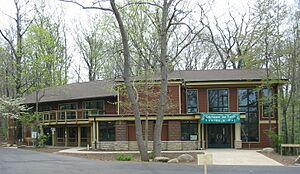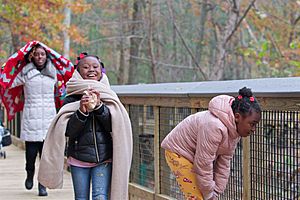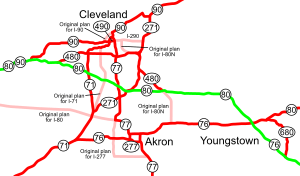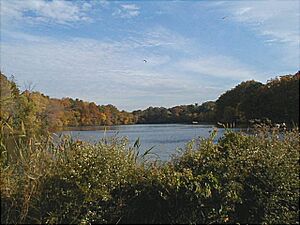Nature Center at Shaker Lakes facts for kids

The Charley Harper-inspired heron greets visitors daily from dawn to dusk.
|
|
| Founded | 1966 |
|---|---|
| Type | 501(c)(3) nonprofit |
| Purpose | Conservation, education |
| Headquarters | 2600 S Park Blvd |
| Location | |
|
Region served
|
Shaker Lakes |
| Services | School programs |
|
Board chair
|
Meg Hunter |
|
Main organ
|
Board |
|
Revenue (2022)
|
$1.82 m |
| Expenses (2022) | $1.87 m |
|
Staff (2022)
|
36 |
The Nature Center at Shaker Lakes is a special place in Shaker Heights, Ohio, USA. It's a nonprofit organization, which means it works for a good cause, not to make money. Its main goals are to protect a beautiful natural area, teach people about nature, and encourage everyone to be good caretakers of the environment.
This center started in 1966 because many volunteers wanted to save the Shaker Parklands. There was a plan to build a new freeway right through this natural space. Thanks to these volunteers, the parklands were saved!
The Nature Center offers fun and educational programs for schools, including young children. Many people enjoy walking, running, and birdwatching on its trails. It's a home for many different animals and plants, living in places like marshes, brooks, fields, forests, and ravines.
Remember, dogs are not allowed on the Nature Center's main trails, except for service dogs. However, some trails around the Nature Center, like the Lower Lake Trail, do welcome dogs.
Contents
Discover the Shaker Lakes Parklands
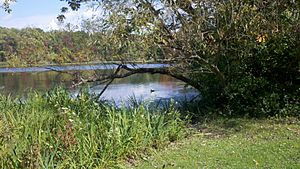
The Shaker Lakes are a group of parklands connected to the Doan Brook Parklands. The Doan Brook stream flows right through them. This park is a mix of natural and wild areas where three towns meet.
Long ago, a group called the Shakers created two lakes here. They built dams on Doan Brook to power their businesses. Today, these swampy and wooded areas are like a small wilderness. They are located in one of the busiest parts of Ohio. This makes them a perfect spot for learning about nature and having fun. People from all over Greater Cleveland can visit year-round for walks, photography, art, nature study, and family time.
It's important to know that the Nature Center at Shaker Lakes does not manage Horseshoe or Lower lakes. These lakes are looked after by another organization called NEORSD.
The Nature Center helps many communities on Cleveland's east side. This includes neighborhoods like Shaker Square and Buckeye. It also serves nearby towns such as Shaker Heights, Cleveland Heights, University Heights, East Cleveland, Beachwood, and South Euclid.
Fun Programs and Ways to Help
The Nature Center at Shaker Lakes has lots of exciting things for kids and families!
- School Field Trips: Students can come for special field trips to learn outdoors.
- Outdoor Adventure Camps: These camps run all year, offering amazing outdoor experiences.
- Nature Events: There are many outdoor classes and events focused on nature, like the yearly "Nature at Night" celebration.
If you are 13 or older, you can also become a volunteer! The Nature Center offers many ways to help. You can join "environmental stewardship" events throughout the year. These events help protect and care for the center's 20 acres (about 8 hectares) of natural land and native plants.
Explore the Nature Center Facilities
The Nature Center at Shaker Lakes has both indoor and outdoor spaces. These are open to everyone and can even be rented for parties or weddings.
- Inside the Center: You'll find classrooms, a meeting room, exhibit areas, and a library. There's also the "Duck Pond," a gift shop with nature-themed items. You can watch birds from the Jean Eakin Bird Observation Station or enjoy views from the Murphy Carfagna Wildlife Balcony. A gallery also overlooks the beautiful grounds.
- Outdoor Trails: Outside, there's an outdoor pavilion, the All People's Trail, and the Stearns Woodland Trail.
All People's Trail: Accessible for Everyone
The All People's Trail is about 0.4 miles (0.6 km) long. It's a special elevated boardwalk designed to be ADA-accessible. This means visitors with all physical abilities can easily enjoy it. A new and improved All People's Trail was built in late 2019 and is now open. It features a charming Rose Foundation Gazebo and a wider boardwalk. There are also special viewing areas for wildlife, perfect for classes and group gatherings.
Stearns Woodland Trail: A Walk Through Nature
The Stearns Woodland Trail is about 1 mile (1.6 km) long. It starts at the Nature Center's Wildflower Garden. This trail winds through different wooded habitats along the south branch of Cleveland's Doan Brook.
A Look Back: The History of the Nature Center
In 1896, the Shaker Lakes Park became part of a larger park system. Later, in 1947, the cities of Shaker Heights and Cleveland Heights took over managing parts of the park.
Saving the Park from a Freeway
In the mid-1960s, there was a big plan to build two new freeways, the Clark and Lee freeways. These freeways would have made it easier to get to Downtown Cleveland. The Clark Freeway was planned to cut right through the park, on both sides of the Doan Brook. The spot where the Nature Center stands today would have been where the two freeways met!
Many people did not want this to happen. A group called the Park Conservation Committee, along with 35 garden clubs and six community groups, led the fight against the freeway. They formed a larger committee called CSTEP. This group organized walks for officials and residents through the park. They talked to schools about why nature education was important. They also encouraged citizens to write letters and protest the freeway.
They even asked the Audubon organization to study if a nature center could work there. The Audubon report said that "For the study of conservation and nature in an outdoor laboratory, there is no comparable area to the park within the limits of Greater Cleveland." This meant the park was a truly special place for learning about nature.
By mid-1966, recreation programs were already happening in the lakes area. Funding was secured to hire a naturalist for school classes that fall. On September 15, 1966, the Shaker Lakes Regional Nature Center was officially created. People started raising money to build a center. They worked with the city of Cleveland to get permission to build. At the same time, the Park Conservation Committee worked to get the center recognized as a National Environmental Education Landmark.
In 1970, a meeting was held where they showed Governor James Rhodes the problems with the proposed freeway. After this, Governor Rhodes decided to remove the Clark Freeway route from the Interstate Highway System. This was a huge victory for the park!
Building and Growing the Center
Maxwell Norcross, a Cleveland architect, designed the Nature Center building. It was mostly paid for by donations from individuals and was finished in November 1969. Gary Nelson became the first full-time director in 1971. That same year, the Stearns Memorial Nature Trail and the Wildflower Garden were built.
Over the years, the center continued to grow. In 1973, the building was updated to add more office and library space. The All People's Trail was built in 1982. In 1985, the Stearns Memorial Trail was redesigned, and an east wing was added to the building. In 2003, the Nature Center renovated its indoor facilities using environmentally friendly building methods. These updates included better and bigger classrooms, community meeting rooms, a nature experience area, a bird observation station, and a gift shop.
Special Recognitions and Awards
The Nature Center at Shaker Lakes has received many important recognitions:
- National Environmental Education Landmark: In 1971, the National Park Service (NPS) named it one of the first organizations to receive this honor.
- National Environmental Study Area: The NPS also recognized it as a special place for environmental study. This is because of the unique learning opportunities offered by its diverse natural habitats in an urban setting.
- Important Bird Area: In 2003, Audubon called it a worldwide Important Bird Area, meaning it's a crucial place for birds.
- Energy Star Award: After its 2003 renovations, the center received the Environmental Protection Agency's 2004 Energy Star Award for being excellent in energy efficiency.
- Certified Wildlife Habitat: In 2006, the National Wildlife Federation certified the Nature Center as an official Wildlife Habitat site.
- National Register of Historic Places: The Nature Center is also listed on the National Register of Historic Places, recognizing its historical importance.


